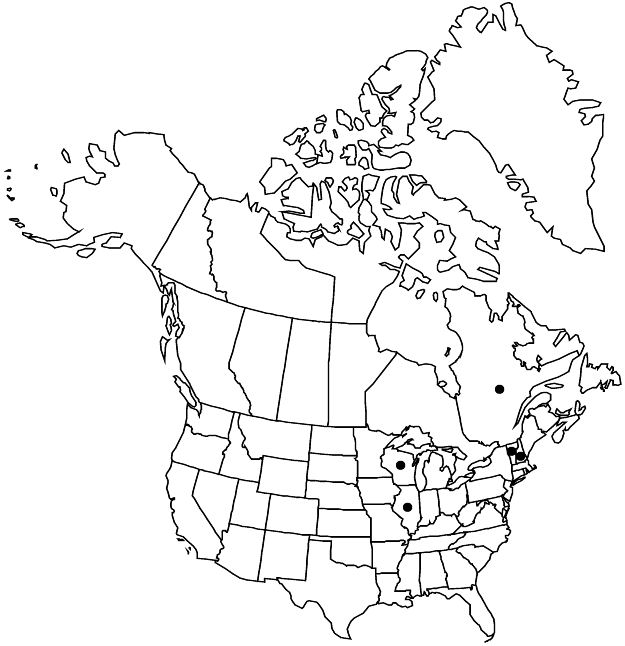Difference between revisions of "Crataegus chrysocarpa var. faxonii"
Bull. New York State Mus. Nat. Hist. 243–244: 64. 1923.
FNA>Volume Importer |
FNA>Volume Importer |
||
| Line 11: | Line 11: | ||
|label=Endemic | |label=Endemic | ||
}} | }} | ||
| − | |basionyms={{Treatment/ID/ | + | |basionyms={{Treatment/ID/Basionym |
|name=Crataegus faxonii | |name=Crataegus faxonii | ||
|authority=Sargent | |authority=Sargent | ||
| + | |publication_title=Rhodora | ||
| + | |publication_place=5: 161. 1903 (as faxoni) | ||
}} | }} | ||
|synonyms={{Treatment/ID/Synonym | |synonyms={{Treatment/ID/Synonym | ||
| Line 33: | Line 35: | ||
|elevation=0–300 m | |elevation=0–300 m | ||
|distribution=Que.;Ill.;N.H.;Vt.;Wis. | |distribution=Que.;Ill.;N.H.;Vt.;Wis. | ||
| − | |discussion=<p>The typical form of the variety may have broadly ovate to broadly elliptic leaf blades 4.5–6 cm with 6–7 veins per side. With far more densely hairy parts than typical <i></i>var.<i> chrysocarpa</i> and the indumentum persistent on the abaxial surfaces of the leaves, <i></i>var.<i> faxonii</i> is an eastern counterpart of <i></i>var.<i> piperi</i>, from which it differs in details of leaf.</p> | + | |discussion=<p>The typical form of the variety may have broadly ovate to broadly elliptic leaf blades 4.5–6 cm with 6–7 veins per side. With far more densely hairy parts than typical <i></i></i>var.<i><i> chrysocarpa</i> and the indumentum persistent on the abaxial surfaces of the leaves, <i></i></i>var.<i><i> faxonii</i> is an eastern counterpart of <i></i></i>var.<i><i> piperi</i>, from which it differs in details of leaf.</p> |
|tables= | |tables= | ||
|references= | |references= | ||
| Line 57: | Line 59: | ||
|publication year=1923 | |publication year=1923 | ||
|special status=Endemic | |special status=Endemic | ||
| − | |source xml=https://jpend@bitbucket.org/aafc-mbb/fna-data-curation.git/src/ | + | |source xml=https://jpend@bitbucket.org/aafc-mbb/fna-data-curation.git/src/f6b125a955440c0872999024f038d74684f65921/coarse_grained_fna_xml/V9/V9_1023.xml |
|subfamily=Rosaceae subfam. Amygdaloideae | |subfamily=Rosaceae subfam. Amygdaloideae | ||
|tribe=Rosaceae tribe Gillenieae | |tribe=Rosaceae tribe Gillenieae | ||
Revision as of 20:34, 24 September 2019
Shrubs, 30–35 dm. Leaves: blade ovate to broadly ovate or broadly elliptic, base rounded to broadly cuneate, sinuses: max LII 5–10%, lobe apex subacute, veins 6 or 7 per side, abaxial surface sparsely tomentose, veins densely tomentose, adaxial with long, soft, white hairs until after flowering, later with many long, not very conspicuous, ± appressed hairs. Inflorescences: branches densely villous. Flowers: 15–20 mm diam.; hypanthium densely villous; stamens 5(–10), anthers cream or ivory. Pomes dark crimson, oblong, full and rounded at ends, 8–10 mm diam., pubescent.
Phenology: Flowering May; fruiting late Sep.
Habitat: Brush, successional fields, unmanaged pastures
Elevation: 0–300 m
Distribution

Que., Ill., N.H., Vt., Wis.
Discussion
The typical form of the variety may have broadly ovate to broadly elliptic leaf blades 4.5–6 cm with 6–7 veins per side. With far more densely hairy parts than typical var. chrysocarpa and the indumentum persistent on the abaxial surfaces of the leaves, var. faxonii is an eastern counterpart of var. piperi, from which it differs in details of leaf.
Selected References
None.